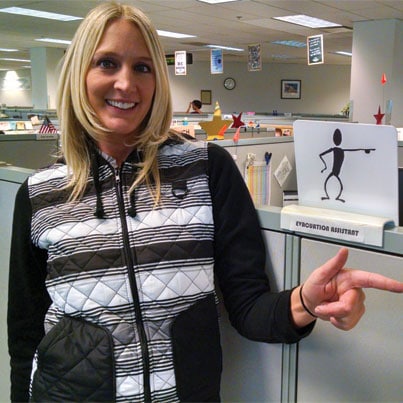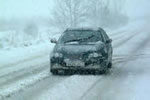by California Casualty | Safety |

It happens every fall; as the first frigid Polar air makes its plunge into the U.S., many of us are scrambling to find the hats, gloves and extra layers we put away for summer.
Hopefully you have had your HVAC system checked and replaced the filters for maximum warmth on these cold days. Here are some more simple tips from Wikihow.com to keep you warm while helping you save on the heating bill:
- Warm rooms by opening window shades when the sun is shining
- Hang cheap, clear shower curtains to block cold air while allowing the sun’s heat in
- Close off unused rooms
- Use rugs and carpets over cold floors
- Cooking with the oven adds heat to your home
- Drink hot liquids
- Wear layers
- Exercise
- Snuggle with a pet
- Get a heating pad or electric blanket
Remember, too, that running ceiling fans in reverse pushes warm air down to the ground.
To help keep you safe, the American Red Cross is launching a new campaign to reduce the risk of home fires that usually increase this time of year. The most essential part of the campaign is to have Americans install and check their smoke alarms and for each household to practice fire drills. The Red Cross also urges everyone to follow these common sense heating safety tips:
- Keep ignition sources like paper, clothing, bedding and curtains at least three feet away from space heaters, stoves and fireplaces
- Never leave heaters and fireplaces unattended
- Place space heaters on a level hard surface like tile floors and away from rugs
- Look for models that have automatic shut off features
- Have wood and coal stoves, fireplaces, chimneys and furnaces professionally inspected and cleaned once a year
Now is also a great time to make sure your family has an emergency kit. According to Ready.gov, it should have enough food and water to survive for a minimum of three days and should also contain:
- A battery powered radio
- Flashlight
- Lots of extra batteries
- First aid kit
- Formula and diapers if you have an infant
- Moist towelettes, garbage bags and plastic ties for sanitation
- Plastic sheeting and duct tape to shelter in place
- Wrench or pliers to turn on and off utilities
- A can opener
- Any essential medications
- Household chlorine bleach to disinfect and treat water
You can find numerous other winter safety preparations and tips at the California Casualty Resources Page. And don’t forget to make sure your vehicle is ready for winter too.
Now is a really good time to make sure your home or apartment is fully protected for fire, ice, wind and other winter damage. Call a California Casualty advisor today for a policy review and to see what discounts you qualify for at 1.800.800.9410 or at www.calcas.com.
Sources for this article:
https://www.wikihow.com/Stay-Warm-at-Home-Without-a-Heater
https://www.redcross.org/prepare/location/home-family/prevent-home-fires/
https://www.ready.gov/build-a-kit
https://mycalcas.com/2012/11/preparing-your-car-for-winter/
by California Casualty | Safety |

Today is America’s PrepareAthon, the culmination of FEMA’s National Preparedness Month. The idea is for individuals, communities and organizations to be prepared for six specific hazards:
The message is that families, businesses and neighborhoods should know their risks, have a plan of action and prepare survival kits.
It got us thinking; “How prepared is California Casualty?”
First, client and employee safety is paramount at California Casualty. Security systems are in place at all our service centers. The company conducts drills for fires and other possible occurrences – complete with trained safety personnel who help with evacuations and account for employees when safety zones are reached. These evacuation assistants are trained in first aid, CPR and the use of automatic electronic defibrillators (AED).
California Casualty has implemented a business continuity and recovery plan should an earthquake, flood, fire, tornado, power outage or winter storm adversely affect operations at one or more of our service centers. Managers carry contact information for every employee so they can be reached in an emergency. Systems are in place so that key personnel can operate remotely and phone and data systems can be shifted to service centers that have not been impacted. This minimizes inconvenience and potential disruption to policy holders.
Yearly table-top disaster scenarios are run to make sure managers know the procedures and backup systems they can utilize. In worse case scenarios, staff can be temporarily relocated to other services centers to maintain the continuity of service to clients. With service centers in Kansas, Colorado, Arizona and California, California Casualty has the redundancies and virtual call routing to maintain operations even if a service center is completely down.
California Casualty also has an emergency outreach plan for clients who may be affected by a disaster. Calls are made to areas that have been hit by flood, fire, tornado, hurricane or flood to make sure our insureds are okay and to expedite help with claims. Our Field Managers and Claims personnel respond to disaster areas to make contact with those insured with California Casualty and aid in their safety, relocation and recovery.
California Casualty works very hard to keep client information and data protected with numerous advanced data security protocols and monitoring. As an added layer of safety, every auto and home insurance policy includes free 911 ID Theft Protection.
Preventing tragedies is also a main concern. California Casualty strives to help our policy holders prepare for various disaster scenarios with many links and preparedness tips at our website’s Resources page.
Are you prepared? Today is the day to make sure with America’s PrepareAthon.
by California Casualty | Safety |
The National Weather Service is describing the ice storm tightening a frozen grip on the southeastern part of the US with words like: Catastrophic, crippling and an even of historical proportions.
Unlike blizzards, ice storms present unique problems that require special preparations.
For your safety, we have excerpted an article from ehow.com on ice storm preparation.
Instructions
Place a winter emergency kit in your car. There are going to be times when a winter ice storm will hit when you are away from the house. Unfortunately, most employers will not let you call out because the weatherman is calling for a winter ice storm. Your winter emergency kit will help you to get home in one piece no matter what you encounter.
Collect all of your flashlights and candles together and make sure that everything is working correctly before the winter ice storm hits. Winter ice storms have been notorious for knocking out power to millions with the weight of the ice on power lines. Do not be left in the dark during the winter ice storm.
Keep your pantry stocked with food that you can eat with out having to cook it. If you lose power during a winter ice storm, you want to make sure that you can still eat. You can also make sure you have all the usual food necessities in case you still have power but are stuck in the house for a few days due to the winter ice storm.
Tips & Warnings
- Try to prepare for a winter ice storm as far in advance as you can. This will keep you home and safe as the storm is on the way.
Read more: ehow.com
Here are some safe driving tips if you encounter ice:
Driving safely on icy roads
- Decrease your speed and leave yourself plenty of room to stop. You should allow at least three times more space than usual between you and the car in front of you.
- Brake gently to avoid skidding. If your wheels start to lock up, ease off the brake.
- Turn on your lights to increase your visibility to other motorists.
- Keep your lights and windshield clean.
- Use low gears to keep traction, especially on hills.
- Don’t use cruise control or overdrive on icy roads.
- Be especially careful on bridges, overpasses and infrequently traveled roads, which will freeze first. Even at temperatures above freezing, if the conditions are wet, you might encounter ice in shady areas or on exposed roadways like bridges.
- Don’t pass snow plows and sanding trucks. The drivers have limited visibility, and you’re likely to find the road in front of them worse than the road behind.
- Don’t assume your vehicle can handle all conditions. Even four-wheel and front-wheel drive vehicles can encounter trouble on winter roads.
If your rear wheels skid…
- Take your foot off the accelerator.
- Steer in the direction you want the front wheels to go. If your rear wheels are sliding left, steer left. If they’re sliding right, steer right.
- If your rear wheels start sliding the other way as you recover, ease the steering wheel toward that side. You might have to steer left and right a few times to get your vehicle completely under control.
- If you have standard brakes, pump them gently.
- If you have anti-lock brakes (ABS), do not pump the brakes. Apply steady pressure to the brakes. You will feel the brakes pulse — this is normal.
If your front wheels skid…
- Take your foot off the gas and shift to neutral, but don’t try to steer immediately.
- As the wheels skid sideways, they will slow the vehicle and traction will return. As it does, steer in the direction you want to go. Then put the transmission in “drive” or release the clutch, and accelerate gently.
by California Casualty | Safety |
As the weather starts to change once again, we look towards the fall season. This means it is important to remember to prepare your house and family accordingly for the season change. Preparing for fall can help save money, and protect your family and home. Check out these tips about preparing your home both inside and out, along with family (including pets).
Inside the house
- Service your furnace / air conditioner. Be sure to call your local heating and cooling company to service and make sure everything is working properly. Double check furnace for any leaks. This will save headaches and money later when the temperatures drop.
- Check to make sure your smoke detectors and carbon monoxide monitors are properly working. It’s important to know the alarms work, and that fresh batteries have been installed. Replace any fire extinguishers that have expired with new ones throughout the home.
- If you keep emergency kits, make sure they are full and stocked with small medical items, water, flashlight with fresh batteries, and any supplies needed. There should be enough to last you and the family about a week.
- Stock up on winter supplies. If you live in a climate where it snows frequently or ices, stock up on shovels, ice scrapers, sidewalk salts, etc. If your climate features heavy rain or hurricanes, make sure you have plenty of tarps, bottled water, duct tape, etc.
- Use caution with space heaters and fireplaces. Place a fireplace screen in front of fire to prevent sparks from flying out. Never leave a burning fire unattended, and make sure the fire is out before going to bed. If your space heater requires ventilation, make sure it vents to the outdoors. Never use a stove or oven to heat home. Always allow three feet of empty area around the space heaters.
Outside the home
- Reconsider burning the big pile of leaves. Check with your city’s regulations. It may be illegal to burn leaves. Burning leaves produce dangerous and cancer-causing chemicals according to the EPA (Environmental Protection Agency). If you are going to burn the leaves, wear a protective mask. Make sure that you are far away from the house or any other structures. Double check the weather forecast for the day for windy activity.
- Watch for power lines if trimming trees in the yard. Look and survey your yard area for power lines hanging above. Notice the placement of your ladder and trimming tools.
- Use caution while using a ladder. If you have to clean leaves out of the gutter, remember to have on appropriate footwear to avoid getting caught in between steps. Watch the steps for water or moisture to avoid slipping and falling. Make sure the ladder is secure and placed before climbing.
- Check all of the outdoor lighting fixtures. Make sure they all are working properly and secure. Outdoor lights are also effective deterrents for crime.
- When you’re cleaning up your yard, prevent injuries by standing straight and upright while raking leaves. Pull from your arms and legs, lift bags with bent knees using your legs, not your back, for support. If you’re using a leaf blower, wear appropriate clothing, eye protection, and tennis shoes or boots to prevent injury.
Family
- Go get a flu shot. There are still possibilities of getting sick after receiving the shot, but it will protect you from severe complications.
- Not just for employees returning to work, wash your hands. Use hot water, plenty of soap, and scrub for at least 30 seconds.
- Bundle up if it is cold. Wear a jacket and dress accordingly.
- Pets. If your furry friend lives outside, feed them more in the cooler times to help them retain body heat.
- Keep an emergency kit in your car. If you haven’t already, make up an emergency kit and keep in your trunk. Some are in stores already made-up. To make your own, include a flashlight with fresh batteries, first-aid kit, jumper cables, windshield washer fluid, and basic tools.
by California Casualty | Safety |
 In many areas, the weather has been pretty good so far this year. But, this week started a flurry (pun intended) of winter weather, and I thought it would be a good time to recap some important safety tips for cold weather!
In many areas, the weather has been pretty good so far this year. But, this week started a flurry (pun intended) of winter weather, and I thought it would be a good time to recap some important safety tips for cold weather!
Winter Care Care Checklist – if you haven’t prepped your car for cold weather, you still have time!
What to do when your pipes freeze – It happens to the best of us (or, at least, it happened to me!). A quick guide to getting your pipes thawed without flooding your house.
Carbon monoxide safety – Firing up your heaters can lead to hidden dangers. Here are some tips for CO prevention.
Driving Safety in Snow and Ice – When the snow and ice come down, the roads get slippery. Here are some tips for making that commute safely.



 In many areas, the weather has been pretty good so far this year. But, this week started a flurry (pun intended) of winter weather, and I thought it would be a good time to recap some important safety tips for cold weather!
In many areas, the weather has been pretty good so far this year. But, this week started a flurry (pun intended) of winter weather, and I thought it would be a good time to recap some important safety tips for cold weather!